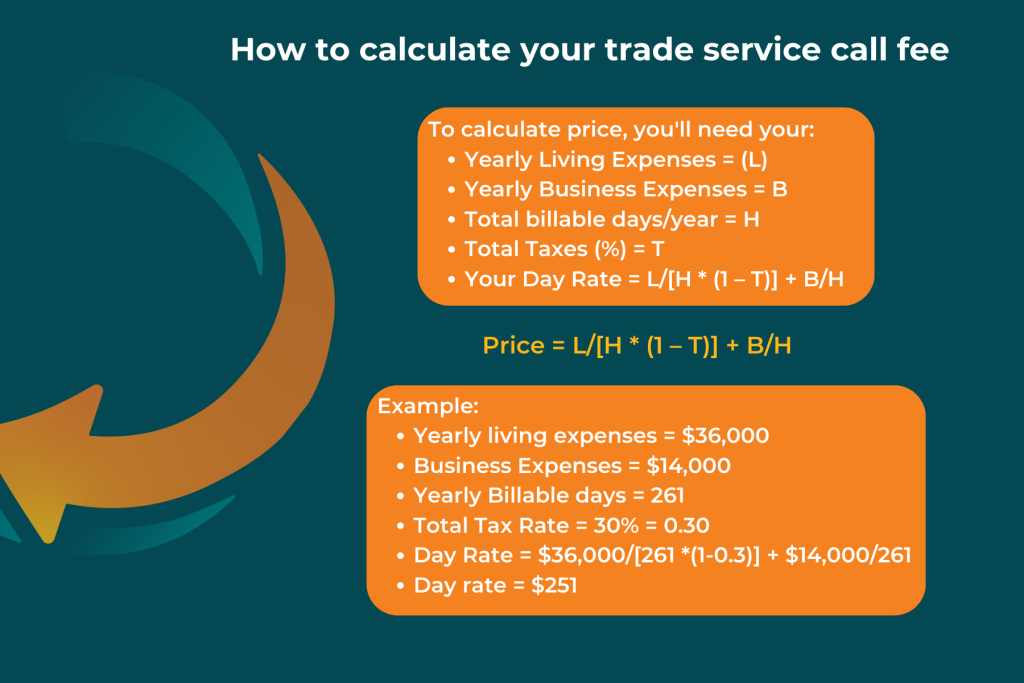What Should I Charge? 3 Methods to Calculate Your Trade Service Fee
May 30, 2023 | Read: 13 minutes

What should I charge for my trade service call fee?
This is the question on every tradesman’s lips and the pinned post on every forum…
The truth of the matter is that every contracting business, whether it’s electrical, plumbing and heating, HVAC, or fire and security, will have to find an answer at some point.
We’re breaking down all you need to know to set the prices that work for your business. You can also download our free guide, to take things even further!
Let’s kick things off by exploring the basics, first, then dive a little deeper:

What is a Trade Service Call?
A trade service call is a journey that a tradesperson (also known as a journeyman or a technician) takes to a customer’s address in order to perform a service check or repairs. The goal is to make sure an appliance is performing as expected and to run a safety check. This can be required by law (e.g. in the case of landlords), by the warranty contract, or simply because a customer wants to make sure their installation is safe and efficient.
Service providers sometimes include these calls as add-ons, either to a subscription (with various coverage levels) or for a one off trade service fee. Homeowners and business owners alike can benefit
The most common types of appliance that will benefit from regular check-ups are:
- Electrical systems
- Air conditioning units
- Major systems essential to a business (e.g. friers or walk-in coolers for restaurants)
- High value home appliances
Charging the Correct Trade Service Call Fee
Pricing the trades should not be a fight to the bottom but a fair reward for skilled workers performing a job that took years of training to learn.
However, the tendency for most companies is to try and compete on who can offer the lowest price, instead of focusing on the best experience and building a sustainable business.
Generally, these fees can be charged either as a one off, or as part of a subscription with different plan options. It’s not a rule, but generally home systems will benefit from from the latter, while landlords and business owners will pay for the former in order to satisfy regulations.
Forbes contributor and author, Kathy Caprino, details how undercharging is a terrible practice for both employees and customers. This is often the result of mental blocks against charging what your business is worth. Not to mention how setting unreasonable pricing expectations for customers affects the industry as a whole.
Charging the correct price means you can:
- Cover all your costs
- Pay your employees a competitive wage
- Bring in a profit that makes running the business worth your time
Being able to do these three things will ensure your business will thrive, your employees will be happy, and you’ll be able to provide an excellent experience to your customers.
How to Calculate a Fee for Trade Service Calls
But how do you not undercharge? What is a reasonable rate? How much should you charge for services in plain numbers?
Here are three methods:
Method 1: Flat-rate pricing (or day-rate pricing)
Without further ado, this is how to calculate what to charge for your services:
- Calculate your living expenses.
- Calculate your business expenses.
- Figure out your taxes.
Use the formula L/[H * (1 – T)] + B/H to determine your day rate. (Don’t worry, we’ll explain this below!)

Let’s break it down:
- Yearly Living Expenses = (L)
- Yearly Business Expenses = B
- Total billable days/year = H
- Total Taxes (%) = T
- Your Day Rate = L/[H * (1 – T)] + B/H
Method 2: Time and materials pricing
This is more of a retrospective method aimed at older companies that have already gathered data on their costs and profits. To start, gather the financial documents that detail the money you’ve earned on a particular job. That can include your receipts, tax documents, or signed contracts. Calculate the total amount paid for the work you did and the amount of time you spent on them.

Compare your hourly pricing and revenue history
Is your historical pricing adequate to meet your needs? If not, you’re undercharging. It’s important to identify why and to correct your pricing accordingly. For example, it could be that you’re often called out to diagnose a fault. If so, it’s key that you make clients aware they’ll pay a call-out charge plus an hourly charge after the first hour. That will make your prices transparent from the beginning.
If you’re afraid that this will upset customers, remember: It’s better to give them an accurate idea of your pricing up front than to have to chase them for money later. Or worse, they might post a negative review online if they think you’ve been dishonest!
Take care of practical considerations
Typically, customers will ask for a fixed or flat-rate price for a work order because then they know there will be no nasty surprises when the bill comes in. So it’s vital to provide one, even for relatively small work orders. The advantage for you is that you can plan your schedule accordingly.
Risks of time and materials pricing
There are a few disadvantages to this style of pricing:
- Jobs that greatly exceed the average in terms of time and cost can drive down your profits
- Customers can request work “since you’re already here” which weren’t on the quote or invoice which can also affect your average numbers
To overcome this, you’ll need to add in a minimum of 15-25% buffer to the price to give yourself a chance of breaking even on work that causes you a headache. So when asking what should I charge, you should always take this into consideration.
Good field service management software will come with a feature to cover these risks.
Usually called additional work orders this feature will help you ensure time and parts won’t get lost in your paper trail. Then if the (paying) customer inquires about anything, you’ll be able to provide a professional answer.
Method 3: Value-Based Pricing
Here are the basic steps to figuring out how to price your services in regards to what they’re truly worth to your customers.
- Know what value means. It’s not the time you spend on-site!
- Set your base hourly rate using your business expenses, desired income, and hours worked.
- Figure out pricing that reflects the value of each type of work order. You can charge more for an after-hours emergency call!
- Consider other factors that determine customer value.
- Put it in writing. A pricing document will ensure your prices are clear to customers.
- If you offer a premium customer experience, then you can and should charge a premium price.
Understanding the Value of your Services
1. Know what value means
As we mentioned in Method 1, the answer to “what should I charge” should never be a simple addition of immediate costs (fuel, tools, parts) and hours spent but the actual, intangible value that you bring to a customer. Here is an out-of-the-box example. Think of the last time you bought a perfume. You probably spent somewhere between $60 and $100, depending on your preferences. A study reported by AOL has shown that the literal value of the item is less than that of a cappuccino: no more than $4.

If you find yourself thinking about what should I charge, this is worth keeping in mind. Think of the needs that these products and services satisfy. A perfume doesn’t have much practical value. It keeps you from smelling bad but so does a shower and that doesn’t cost $60! What about being without power in the middle of the winter? It might be just because of a faulty wire that costs little more than change to fix but the value you bring to your customer far exceeds that of the materials.
What about the value of a code correction to a company that stood to be fined a fortune for electrical code violations? We’re not saying that you should take advantage of customers in difficult situations but don’t fall into the trap of thinking your work isn’t worth the reward.
2. Set your base hourly rate using your business expenses
Of course, there are industries where the margins are naturally higher compared to the production costs. What we’re trying to say is that the rest added on top of immediate costs needs to cover everything, from marketing to warehouse rent to delivery. The answer to what should I charge is that only what you add on top of this will be your profit.
Going back to the previous example: If a bottle of perfume costs $4 to make and you’ve paid $60, that doesn’t mean that $56 is pure profit. More likely that less than half of that goes into the pocket of the company. Don’t even get us started on how much profit should go back into the business. That’s a lesson for another day! But if you’re interested, you can learn all about net profit per hour.
So make sure that when you settle on a price, you’ve covered every cost and if you’re not certain, just scroll up to our first method, or click below to see how the invoice email should look like with our free communication templates set. Download the Customer Communication Toolkit now!
3. A trade service call fee reflects the value of each type of job
Always consider more than just hourly labor when calculating your charge. A standard installation inspection with 25 appliances should have a different price from fitting a new alarm system!
Remember, the value to the customer is unrelated to your time. The value to your customer isn’t how much time you spent, but that they now have a pool pump that won’t break down. That’s where call-out charges and standard service fees come in. A call-out charge makes sure every job is worth your while, and a standard service charge aligns your price to take into account customer value.
So in your Terms and Conditions, you might state that a standard check-up costs $80. That makes it crystal clear to the customer that your time has value and will also give you a good margin.
4. Other factors that determine homeowner value
What makes it more difficult to understand what should you charge is that many outside factors specific to your business come into play. The most important is your target market. For example, where you operate in the country makes a big difference. A city center is more expensive than a small town. Customers will have different means of covering costs and different priorities.
Someone with a day job will appreciate it all the more if you can send a tech around after work hours, saving them having to take a full day off. But if you find that you’re working for retired individuals or work-from-home types more often than not, it’s worth factoring that into your work day and prices.
If you’re still feeling unsure, it’s always a good idea to see how much the competitors are charging for their trade service call fee and how they’ve structured their pricing. For example, are the majority of their jobs billed as flat rate fees, or are they charging by time and materials? Would it make sense for your business to do the same?
And while it’s great to learn from others, keep in mind that you should determine your pricing based on what will work best for your business. Maybe they’re waiving their diagnostic fees, but that isn’t the right move for your company. That’s perfectly okay! It’s all about finding the right balance.
5. Put your trade service call fee in writing
Your terms and conditions should be an area of your business where it’s worth either spending more time or hiring a contract expert. Everything from deposits and deferred payments to invoices and charges should be in here. This way, you know that even if there’s a technical issue with a customer, you’re covered by your T&Cs.
Once you have an hourly rate that reflects the value you offer, write a pricing document with your terms and conditions. Then send this to your customers when they book work, so you’re clear and upfront about your prices. Yes, this should also be part of the answer to the eternal what should I charge question.
When you have a professional-looking pricing document, there’s no opportunity for customers to misunderstand and, equally important, no confusion on your side. You’ll never again have to ask yourself, ‘Is $50 too much for that quick 20-minute check-up?’.
6. Offer premium customer service and charge a premium service call fee
Finally, we’ve discussed how field service customer experience has overtaken price as a key decision factor since 2020.
So, it’s high time that you make sure you’re focusing more on offering an experience than a cheap service.
More and more people will look for a positive impression than saving a couple of bucks, especially if it’s the kind of service that makes you stand out from the competition.
How to Chase a Service Call Fee Payment
Now that you know what to charge, it’s important you’re covering all bases so that you can get paid.
After all, there will always be customers who try to wiggle out of a bill, but that doesn’t mean you should make it easy for them.
So how do you politely chase payment in an email without alienating customers?
Well, there’s actually a lot more to it than just listing a price. Remember that:
- Phrasing matters! “As per our T&Cs, a 5% interest rate will be charged for each exceeding day.” is a respectful way of reminding the customer they’ll be charged more if they don’t pay their bill, while “Pay now or suffer the consequences.” makes you sound like a mobster
- An invoice should be clear. It needs to make sense to the customer, not just to your office manager or a service technician
- Urgency is key. When it’s clear that a customer needs to pay soon (as well as what they’re being chased for), they’re much more likely to pay attention.
To give you a head-start on chasing payments, we’ve put together a series of ready-made email templates, which you can copy and paste, then adapt to your situation.
Download The Communication Toolkit now to find out more!
Start Analyzing your Trade Service Call Strategies!
It’s difficult to calculate the right trade service call fee if you don’t know what your current costs are.
The best way to keep track of all your invoices, parts costs, and other outgoings is to manage everything on one screen with the right software.
The good news is, Commusoft’s here to help on both fronts. Explore our job management software features and be sure to download our separate service pricing checklist guide, so you can calculate the prices that’ll benefit your business.

Cristina Maria
I'm here to bring you next-level strategies to the field service industry. When I'm not working on the best tips to grow your business, I'm on the lookout for sci-fi novels and cookie recipes.







